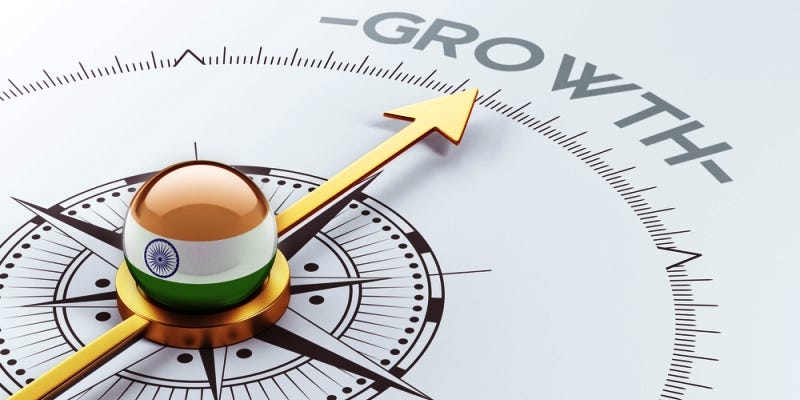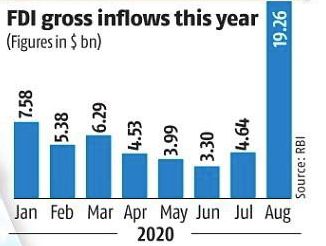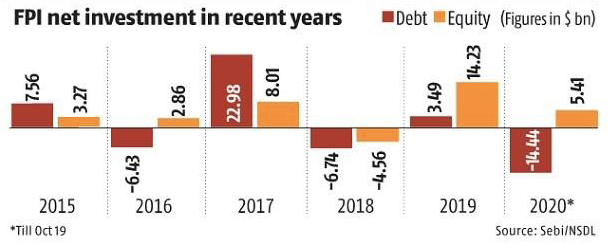SFO + Virtual Global Investor Roundtable — Financing India 5 Trillion USD Economy Growth Story

- Virtual Global Investor Roundtable (VGIR) 2020 was held on 6th November 2020 soliciting global investments into India to make it a 5 Trillions USD economy.
- India, which has one of the lowest corporate tax rates in the world, is the best place for generating long-term returns .
- VGIR 2020 focussed on discussions around India’s economic and investment outlook, structural reforms and the government’s vision for making the country a USD 5-trillion economy.


- The Indian side at the roundtable is represented by business leaders, financial market regulators, Finance Minister Nirmala Sitharaman and RBI Governor Shaktikanta Das.
- The global institutional investors, representing key regions including the US, Europe, Canada, South Korea, Japan, the Middle East, Australia and Singapore, will participate in VGIR 2020, and some of these investors would engage with the government for the first time.
Some of the prominent Sovereign Funds, Pension Funds and Financial Institutions participating in the event are as follows. These pension and sovereign wealth funds have total assets under management of about USD 6 trillion .
- Temasek.
- AustralianSuper.
- CDPQ.
- CPP Investments.
- GIC.
- Future Fund.
- Japan Post Bank.
- Japan Bank for International Cooperation.
- Korean Investment Corporation.
- Nippon Life.
- Mubadala Investment Company.
- Ontario Teachers.
- Teachers Retirement Texas.
- Pension Denmark.
Apart from this, there will be six major Indian industrialists to share their experience.
- Deepak Parekh (HDFC).
- Dilip Shanghvi (Sun Pharma).
- Mukesh Ambani (RIL).
- Nadan Nilekani (Infosys).
- Ratan Tata (Tata Group).
- Uday Kotak (Kotak Mahindra Bank).
VGIR 2020 will also provide an occasion for all stakeholders to further cement the strong partnerships that have been built and foster engagement with international institutional investors who are looking to increase their Indian investments.
- India offers “democracy, demography, demand as well as diversity. Such is the diversity that you get multiple markets within one market. These come with multiple weathers and multiple levels of development”.
- The country’s growth has the potential to catalyse global economic resurgence as “any achievements by India will have a multiplier impact on world’s development and welfare”.
- Today, investors are moving towards companies which have a high environmental, social & governance score. India already has systems and companies which rank high on this.
- India’s recent reforms in agriculture open up new exciting possibilities to partner with the farmers of India. With the help of technology and modern processing solutions, India will soon emerge as an agriculture export hub.
- India’s quest to become AatmaNirbhar ( Self Relaint )is not just a vision but a well-planned economic strategy; a strategy that aims to use the capabilities of our businesses and skills of our workers to make India into a global manufacturing powerhouse.
- India has shown remarkable resilience in this pandemic, be it fighting the virus or ensuring economic stability. This resilience is driven by the strength of our systems, support of our people and stability of our policies.
- It is because of the strength of our system that we could provide foodgrains to around 800 million people, money to 420 million people and free cooking gas to around 80 million families.
- A strong and vibrant India can contribute to stabilization of the world economic order. We will do whatever it takes to make India the engine of global growth resurgence.
- If you want returns with reliability, India is the place to be.
- If you want demand with democracy, India is the place to be.
- If you want stability with sustainability, India is the place to be.
- If you want growth with a green approach, India is the place to be.
- India believes in following the path of growth with equal focus on ESG. India offers you democracy, demography, demand, and diversity.
- India is conscious of investors requirement to provide their funds in trust with best and safest returns. India emphasises an approach is of finding long-term and sustainable solutions for issues.
Timing of VGIR brings in twin advantages
- It comes in the backdrop of several efforts made by India to improve the country’s investment climate and at a time when investors are looking to de-risk businesses and investments by reducing dependence on China
- It shall help promote investments in capital-starved sectors like infrastructure. The main purpose of the meeting is to assess their views on reforms that are required to attract long-term capital into the country.
- The development comes at a time when capital expenditure has seen a significant fall in view of the Covid-19 pandemic, with companies going slow on their new projects.
- Fund houses from all over the world are in touch with us and want us to provide good assets and required patent capital (long-term capital) with not a very high, but stable return. We are working towards it.
- The meeting with global investors would be a confidence booster as it signalled a high degree of commitment . This is a good signal for foreign funds to be invested and interested in the India story.
- Apart from infrastructure, health care and digital space were among the areas that had huge scope for foreign investments.
- Fund managers, too, see this meeting as an opportunity to fill the gap that has been created amid issues concerning China.
- When the prime minister of a country engages with investors, it brings serious money on the table at a lower risk premium. Investors will demand lesser premium when they get confidence… (It will also bring) other benefits like longer-term commitment, technology, and follow-through support. India and China were of similar size in the 80s. In four decades, they have become five times bigger than us. Such engagements will help us narrow the gap with China.
- The government is exploring possibilities to channelise domestic savings and domestic assets in the country. There are about Rs 16-trillion domestic assets which could be channeled. For instance, in the case of the Employees Provident Fund, rules should be made in a manner that it is allowed to put money in the infrastructure sector.
- The EPFO uses its corpus (estimated at Rs 13–14 trillion in last fiscal) to earn income from investments in debt instruments and equities.
- Investment in equities is capped at 15 per cent. The remaining funds are invested in debt.
- The Govt is trying to cajole ministries and public sector enterprises to push infra spending, and will provide more money if needed to revise estimates.
- Further, the production-linked incentive scheme for mobile phones, pharma products, and medical equipment will be extended to seven-eight sectors. This comes after a positive response from mobile manufacturers, which shows diversification in the supply chain. Sunrise sectors were proposed to be included in the scheme.
National Infrastructure Pipeline for 2019–2025
- To achieve the GDP of $5 trillion by 2024–25, India needs to spend about $1.4 trillion (Rs. 100 lakh crore) over these years on infrastructure. In the past decade (FY 2008–17), India invested about $1.1 trillion on infrastructure. The challenge is to step-up annual infrastructure investment so that lack of infrastructure does not become a binding constraint on the growth of the Indian economy.
- To achieve this objective, a Task Force was constituted to draw up the National Infrastructure Pipeline (NIP) for each of the years from FY 2019–20 to FY 2024–25 with the approval of the Finance Minister. The Task Force is chaired by Secretary, DEA with CEO (NITI Aayog), Secretary (Expenditure), Secretary of the Administrative Ministries, and Additional Secretary (Investments), DEA as members and Joint Secretary (IPF), DEA as Member Secretary.
- The first meeting of the Task Force was held in September 2019. Subsequently, several meetings were held with various Departments/Ministries engaged in infrastructure development, Corporates engaged in infrastructure development & construction, Banks/Financial Institutions, Private Equity funds, and Industry Associations, including CII, FICCI & ASSOCHAM, to seek information as well as suggestions on reforms required in infrastructure sectors.
- This exercise, the first of its kind, is expected to be followed up by a periodical review process. NIP will enable a forward outlook on infrastructure projects which will create jobs, improve ease of living, and provide equitable access to infrastructure for all, thereby making growth more inclusive. NIP includes economic and social infrastructure projects.
- On the basis of the information compiled as on date, total project capital expenditure in infrastructure sectors in India during the fiscals 2020 to 2025 is projected at over Rs 102 lakh crore.
- During the fiscals 2020 to 2025, sectors such as Energy (24%), Roads (19%), Urban (16%), and Railways (13%) amount to around 70% of the projected capital expenditure in infrastructure in India. The detailed sector wise break of the pipeline is as follows. The numbers are in INR Crores:
Energy
- Power- 1175995
- Renewable Energy — 929500
- Atomic Energy -154088
- Petroleum and Natural Gas- 194666
- Total Energy — 2,454,249
Roads
- Roads — 1,963,943
- Total Roads — 1,963,943
Railways
- Railways — 1,368,523
- Total Railways- 1,368,523
Ports
- Ports — 100,923
- Total Ports — 100,923
Airports
- Airports — 143,398
- Total Airports — 143,398
Urban
- AMRUT, SMART Cities, MRTS, Affordable Housing, Jal Jeevan Mission — 1,629,012
- Total Urban — 1,629,012
Telecommunication
- Telecommunication — 320,498
- Total Telecommunications — 320,498
Irrigation
- Irrigation — 772,678
- Total Irrigation — 772,678
Rural Infrastructure
- Rural Infrastructure — 410,955
- Water and Sanitation — 361,810
- Total Rural Infrastructure — 772,765
Agriculture and Food Processing Infrastructure
- Agriculture Infrastructure — 54,298
- Food Processing Industries — 1,255
- Food and Public Distribution — 5,000
- Total Agriculture and Food Processing Infrastructure — 60,553
Social Infrastructure
- Higher Education — 118,348
- School Education — 37,791
- Health and Family Welfare — 168,622
- Sports — 7,618
- Tourism- 24,321
- Total Social Infrastructure — 356,701
Industrial Infrastructure
- Industries and Internal Trade — 299,237
- Steel- 8,225
- Total Industrial Infrastructure — 307,462
TOTAL (Rs. Crore) — 10,250,704
- Out of the total expected capital expenditure of Rs. 102 lakh crore, projects worth Rs 42.7 lakh crore (42%) are under implementation, projects worth Rs 32.7 lakh crore (32%) are in conceptualization stage and rest are under development. It is expected that projects of certain states, who are yet to communicate their pipelines, would be added to the pipeline in due course.
- We at the Task Force in our detailed report have given recommendations on changes required to several key sectoral policies and other reform initiatives to be initiated by Central and State Governments. A monitoring mechanism has also been suggested to ensure timely implementation.
A copy of Report of Task force is attached here
